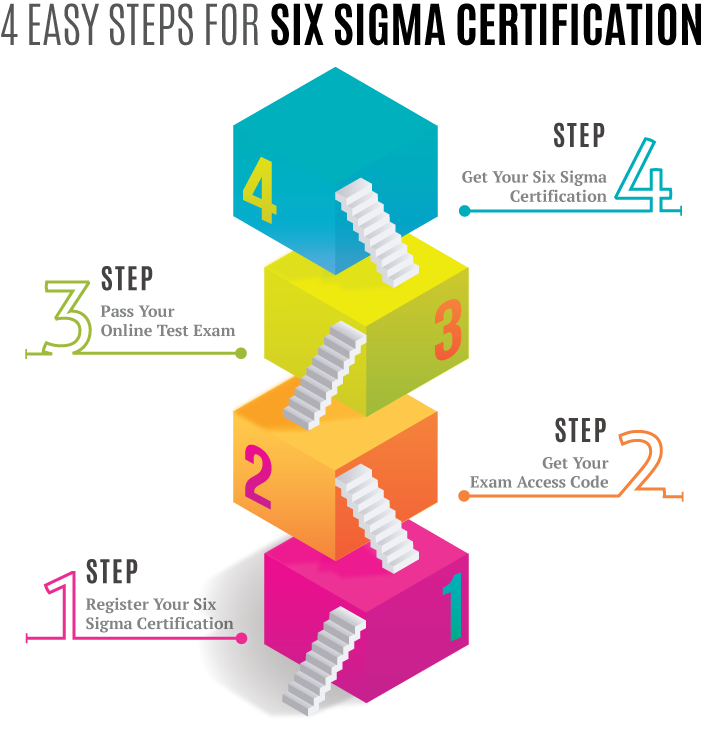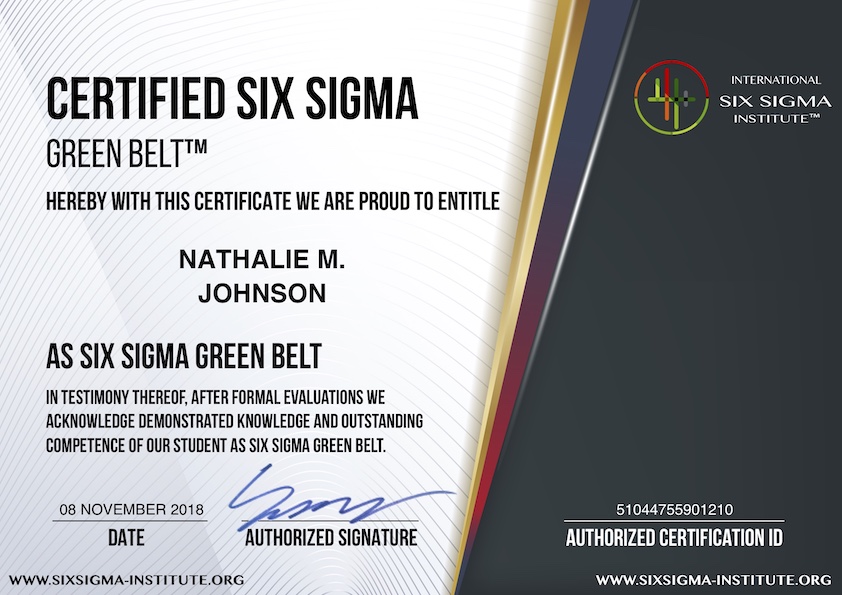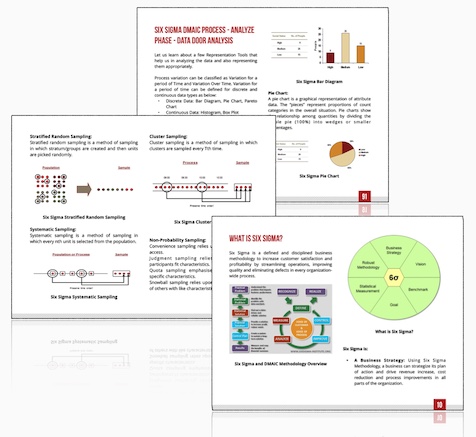What is Quality in Six Sigma? Definition & Importance
In its core, Six Sigma Quality constitutes a systematic, evidence-centered tactic geared at wiping out errors and cutting down on inconsistency within operations. It aims for close-to-perfect outcomes by restricting mistakes to just 3.4 in every million chances. To give that a real frame, if we think about pizza delivery, Six Sigma would tolerate only 3.4 messed-up deliveries out of a million. The quest for perfection in Six Sigma means striving continually for upgrades to get as close as possible to flawless quality. This path calls for a sturdy dedication to comprehending customer wants, slimming down procedure disparity, and boosting overall performance. We're ready to get more into how excellence is sought in this approach.
In Six Sigma, quality is defined as the level of conformity to customer requirements and the degree to which a product or service meets or exceeds those requirements. It encompasses defect reduction, process improvement, and ultimately aims for 3.4 defects per million opportunities, representing exceptionally high standards.

What is Quality in Six Sigma?
Understanding Six Sigma Quality
Imagine you're ordering a pizza. If you expect it to arrive piping hot and delicious, delivered right to your doorstep without any errors, then you're looking for something that mirrors the principles of Six Sigma Quality.
In this context, a defect would equate to something missing from your order, like a misplaced topping or an incorrect pizza size. Now, imagine if a pizzeria delivered 3.4 incorrect orders out of every million. That's essentially what Six Sigma Quality guarantees—a level of consistency and precision so high that the possibility of encountering an error becomes nearly negligible.
So, in real-world terms, Six Sigma Quality is synonymous with perfection—getting things right almost every single time. It's not about aiming for zero defects, but rather minimizing them to such an extent that they become statistically insignificant.
To illustrate this concept further, consider the manufacturing process in an automobile plant. Implementing Six Sigma Quality would mean ensuring that only 3.4 out of every million cars produced have significant defects, leading to extraordinary levels of customer satisfaction and loyalty.
The heart of this approach lies in its deep reliance on precise data analysis and strategic problem-solving methodologies. It aims to identify underlying causes of variation and defects and then systematically work towards eliminating them, ultimately leading to more streamlined processes and, by extension, higher quality products or services.
As we explore the intricacies of Six Sigma Quality, it becomes increasingly clear just how impactful these principles can be in driving operational excellence and achieving exceptional results.
What is Quality? (Multiple Definitions from Many Perspective of Excellence!)
Different individuals and organizations have given different definitions for Quality. Let’s study some of those definitions:
- Deming: "Quality is defined from the customer’s point of view as anything that enhances their satisfaction".
- Juran: "Fitness for use. Those product features which meet the needs of customers and thereby provide product satisfaction. Freedom from deficiencies".
- ASQC: "The totality of features and characteristics of a product or service that bear on its ability to satisfy stated or implied needs".
- COPC: "Quality is defined as knowledge of agents that would enable them to provide accurate and consistent solution to the customer at the very first attempt".
- ISO: "Degree to which a set of inherent characteristics, of a product or service, fulfill requirements".
Simply stated, quality comes from meeting customer expectations. This occurs as a result of four activities:
- Understanding customer requirements.
- Designing products and services that satisfy those requirements.
- Developing processes that are capable of producing those products and services.
- Controlling and managing those processes so they consistently deliver to their capabilities.
Excellence Pursuit in Six Sigma Processes
In the world of Six Sigma, excellence isn't just a buzzword—it's a way of life. The pursuit of excellence within Six Sigma processes revolves around the relentless drive to achieve near-perfect quality through continuous improvement.
This pursuit isn't about aiming for perfection, as that is often unattainable, but rather focusing on getting as close to it as possible. It involves thoroughly understanding customer needs and expectations, identifying areas for improvement, and implementing changes to enhance performance.
Excellence in Six Sigma also means addressing process variation. This refers to the natural differences in the outputs of a process or system, which can affect product quality and consistency. By reducing variation, organizations can achieve greater control over their processes, leading to higher quality outcomes.
Imagine you're baking cookies. If your oven temperature fluctuates widely (variation), your cookies might not bake evenly every time. However, if you manage to reduce this variation in temperature, your cookies will turn out consistently perfect every time.
By emphasizing the reduction of process variation, Six Sigma seeks to ensure that products and services meet or exceed customer expectations each time. This drives customer satisfaction and strengthens brand loyalty.
Understanding the importance of minimizing variation is key to achieving consistent quality, and that's what the pursuit of excellence in Six Sigma is all about—creating predictable and superior outcomes that delight customers while driving organizational success.
Now, let's delve into how this pursuit of excellence is manifested through specific tools and methodologies in the world of Six Sigma.
Decode DMAIC: Define, Measure, Analyze, Improve, Control
The DMAIC methodology is the foundation of Six Sigma practices, guiding teams through a systematic approach to process improvement. Each phase serves as a stepping stone toward identifying and addressing opportunities for enhancement. Let's explore each phase to understand its significance and impact on quality management and process optimization.
Define
In the Define phase of DMAIC, project goals, scope, and deliverables lay the groundwork for the entire improvement journey. This is where the team sets a clear understanding of what needs to be achieved and defined customer requirements are established. It's like planning a road trip: you need to know your destination and map out the route before you hit the road.
This phase is crucial for understanding customer needs and expectations. By identifying Critical to Quality (CTQ) parameters, the team can pinpoint what truly matters to the customer. This is akin to deciphering the essential ingredients in a recipe – without understanding what makes the dish outstanding, how can we aim for perfection?
For instance, in a manufacturing setting, if customers expect precision in product dimensions or rapid order processing times, these CTQs need to be measured and aligned with the project goals early on.
Measure
Once the path is charted in the Define phase, it's time to measure where the current process stands. Imagine this as taking an initial reading before starting an exercise routine. In the Measure phase, we use data and metrics to get an accurate picture of how things are going currently.
Here, it's all about putting numbers to our understanding of the process performance. By quantifying existing process metrics, we establish a baseline that helps us gauge improvement down the line. Just like measuring one’s initial weight before embarking on a fitness program.
An example of this would be accurately measuring production cycle times or error rates in a service-based process. These measurements provide insights into how efficient or effective the current state of operations is.
Analyze
Now that we have detailed information at hand from measuring, it’s time to sift through it methodically in the Analyze phase. The team digs deep here to unearth root causes – it’s akin to identifying reasons why a plant isn’t growing healthily before addressing its needs.
Identifying core defects or inefficiencies within the process enables informed decision-making for improvements. This phase is all about meticulous analysis and problem-solving - much like solving a complex puzzle by identifying its fundamental pieces.
By utilizing tools such as Pareto charts or Fishbone diagrams and statistical analysis techniques during this step, teams can pinpoint areas that need attention.
This forms the basis for targeted improvements in the next phase.
Moving forward from analyzing root causes comes implementing solutions for improvement in Six Sigma processes.
Advancing from analyzing root causes comes exploring strategies for implementing solutions in Six Sigma processes.
Scrutinizing Quality with Sigma Levels
In the world of Six Sigma, Sigma levels play a crucial role in measuring process efficiency and error rates. They act as a scorecard for evaluating how well a process performs, likened to a race where the goal is to reach the finish line swiftly without stumbling.
Now, let's talk more about what these Sigma levels mean: A sigma level quantifies the effectiveness of a process in producing flawless products.
Fewer mistakes result in higher sigma levels, signifying excellent process performance.
What Do Different Sigma Levels Mean?
Here's what different sigma levels indicate in terms of defects per million opportunities:
| Sigma Level | Defects per Million Opportunities |
|---|
| 1 | 30,000 |
| 2 | 308,537 |
| 3 | 66,807 |
| 4 | 6,210 |
| 5 | 233 |
| 6 | 3.4 |
This means that if a process is running at Six Sigma (Level 6), there are just 3.4 mistakes for every million chances to make one. It’s akin to consistently hitting the bullseye when throwing darts.
Imagine if companies could produce nearly flawless products! This would lead to decreased returns, increased customer satisfaction, and reduced time spent remaking items. Businesses favor high sigma levels because they signal exceptional performance.
For instance, a process operating at Six Sigma levels is considered to have an extremely low defect rate, reflecting a high standard of quality.
So there you have it: whether it's about making cars, clothing, or computer software, understanding and improving sigma levels empowers companies to deliver near-perfect work across various industries.

Quality in Six Sigma
The Upside of Embracing Six Sigma Quality
So, what’s all the fuss about Six Sigma? Is it just a flavor-of-the-month business strategy, or does it offer substantive value? Well, for starters, organizations that adopt Six Sigma quality tend to experience a surge in customer satisfaction. This stems from the method's focus on identifying and addressing defects at their source, thus improving overall product quality.
Moreover, by honing in on process efficiency, Six Sigma can boost productivity by a significant margin. Studies indicate an average increase in process efficiency of 25% after implementing Six Sigma quality. This enhanced efficiency translates into tangible cost reductions and higher profitability for businesses.
The methodology meticulously targets the root causes of defects, leading to consistent, high-quality output. At its core, Six Sigma is all about nipping issues in the bud rather than scrambling to fix them when they've already ripened into costly complications.
Not only does this approach lead to improved customer satisfaction and increased process efficiency, but it also cuts down on costs significantly. Organizations have observed a 50% reduction in defects after implementing Six Sigma quality. Imagine the impact of cutting your defects in half! It's not just about fewer errors; it's about fostering a culture of continuous improvement where every process is examined and refined to prevent future mistakes.
And the benefits don't stop there. Implementing Six Sigma quality makes better use of resources – both human and financial - which in turn drives up profits. Organizations notice a 30% increase in customer satisfaction scores after embracing Six Sigma methods – that's no small feat! It's a dramatic illustration of how aligning your operations with customer needs can yield big rewards.
In summary, embracing Six Sigma Quality isn't just a choice - it's a strategic move that brings about tangible benefits such as improved customer satisfaction, increased process efficiency, reduced costs, and higher profitability for businesses. It's an investment in continuous progress and excellence that pays dividends in multiple areas of operation.
This valuable methodology proves that focusing on quality doesn't just lead to happier customers but also fosters resilience within organizations. Now, let's explore how you can practically implement Six Sigma Quality within your organization.
Implementing Six Sigma Quality in Your Organization
Embarking on a journey towards implementing Six Sigma Quality within your organization can have a profound impact, setting the stage for elevated operational efficiency and excellence. So, where do you start?
Leadership Commitment
To kick-start this transformative journey, securing
leadership commitment is pivotal. It's crucial to have the full buy-in and involvement of organizational leaders to spearhead the cultural and operational changes necessary for successful implementation. This involves not just verbal support but also active engagement in driving the change and fostering an environment conducive to effective application of Six Sigma principles.
Leaders who champion Six Sigma quality can motivate and inspire team members to embrace the methodologies and actively contribute to process improvements. Their visible involvement underscores the gravity of the initiative and encourages cooperation at all levels of the organization.
Training and Education
Blending theoretical knowledge with practical application, providing comprehensive
training and education to staff at all levels sustains intrinsic understanding and adoption of Six Sigma methodologies. This ensures that employees comprehend the underlying principles, tools, and techniques essential for effective project execution.
By arming employees at every level with Six Sigma expertise, organizations enable greater collaboration across departments, fostering a cohesive approach to problem-solving and continuous improvement—critical tenets of Six Sigma methodology.
Project Selection
The selection of appropriate projects plays a crucial role in the successful implementation of Six Sigma Quality. It's imperative to align chosen projects with strategic goals while prioritizing those that wield a high impact on critical business processes. Projects should be carefully evaluated to ensure they are in sync with the overarching vision and goals of the organization.
Identifying projects with substantial potential for process optimization enables organizations to focus efforts on areas that directly contribute to enhanced productivity, cost efficiencies, and superior customer satisfaction—a core objective of Six Sigma strategy.
Infrastructure
Establishing a robust
infrastructure serves as the backbone for executing and sustaining Six Sigma initiatives. This includes forming dedicated teams proficient in Six Sigma methodologies, allocating adequate resources, defining project charters, and outlining streamlined processes essential for project execution.
A structured infrastructure ensures that requisite resources are channeled effectively towards project requirements—facilitating seamless execution and driving tangible results.
Implementing Six Sigma quality within your organization encompasses proactive leadership involvement, comprehensive training, strategic project selection, and a resilient infrastructure—all converging to shape a culture of continuous improvement and excellence.
In conclusion, the successful integration of Six Sigma principles not only paves the way for substantial operational enhancements but also fosters an environment where a commitment to quality becomes ingrained in the very fabric of your organization.
What are the key principles of quality management within Six Sigma?
Answer: The key principles of quality management within Six Sigma are customer focus, continuous improvement, data-driven decision making, and process efficiency. These principles aim to create products or services that meet or exceed customer expectations, reduce defects and errors, increase productivity, and drive innovation. According to a study by the International Six Sigma Institute, organizations implementing Six Sigma saw an average cost savings of $427,000 per project and a 46% increase in customer satisfaction.
How is quality defined and measured in the context of Six Sigma?
Answer: Quality in the context of Six Sigma is defined as meeting customer requirements and reducing defects to a near-zero level. It is measured by using statistical tools such as process capability analysis, control charts, and defect rates. The goal of Six Sigma is to achieve a sigma level of 6, which corresponds to a defect rate of 3.4 parts per million, indicating a high level of quality. Organizations that implement Six Sigma have reported significant improvements in quality metrics, such as reduction in defects, customer complaints, and costs of poor quality.
Can you provide examples of successful implementation of quality initiatives using Six Sigma?
Answer: Yes, there have been several successful implementations of quality initiatives using Six Sigma in various industries. One example is General Electric (GE), which implemented Six Sigma and achieved significant results. GE reported saving over $2 billion within five years and improving customer satisfaction by 73%. Another example is Motorola, which saved around $16 billion by implementing Six Sigma, leading to a 10-fold increase in profits. These success stories highlight the effectiveness of Six Sigma in improving processes, reducing errors, and driving financial gains for organizations.
How does Six Sigma approach improving quality in processes and products?
Answer: Six Sigma approaches improving quality in processes and products by utilizing a data-driven methodology to identify and reduce variation and defects. It focuses on measuring performance, analyzing root causes of issues, implementing improvements, and controlling the process to sustain results. By employing statistical tools and techniques such as DMAIC (Define, Measure, Analyze, Improve, Control), Six Sigma aims to achieve a level of quality where the probability of defects is extremely low (3.4 or less per million opportunities). This approach has been successful in various industries and has led to significant improvements in process efficiency, customer satisfaction, and cost savings.
What role does statistical analysis play in measuring and improving quality in Six Sigma?
Answer: Statistical analysis plays a critical role in measuring and improving quality in Six Sigma. It helps identify trends, patterns, and variations in data, enabling practitioners to make data-driven decisions for process improvement. By applying tools such as control charts, hypothesis testing, regression analysis, and design of experiments, statistical analysis provides insights into the root causes of defects and helps evaluate process performance. For instance, statistics can quantify process capability by measuring the deviation from the target value or calculating the sigma level. This allows organizations to set realistic goals, prioritize improvement efforts, and track progress towards achieving higher quality standards.
What is quality?
Answer: Quality, in the context of Six Sigma, is a term that encapsulates the adherence to established standards and the fulfillment of customer expectations. It involves a series of steps meticulously designed to eliminate waste and address problems systematically, ensuring that the end product or service aligns with the company's predefined criteria. People, including both employees and customers, play a vital role in determining the success of quality initiatives, emphasizing the collaborative efforts required to achieve and maintain high standards. The quality engineer, as a key figure in this process, is instrumental in implementing methodologies to enhance processes and deliver superior products or services.
Quality is defined by the customer is ...
Answer: Quality is defined by the customer in Six Sigma, highlighting the significance of aligning products or services with customer expectations. In this context, the professional responsible for quality must employ effective measurement techniques to ensure that the end result meets or exceeds customer-defined criteria. Lean principles emphasize the elimination of waste and the optimization of processes to enhance overall quality. The responsibilities of the quality professional within Lean Six Sigma extend beyond mere compliance with standards, emphasizing continuous improvement and customer satisfaction.
Define quality
Answer: Quality, in the Six Sigma philosophy, is defined by professionals as the degree to which a product or service fulfills its intended purpose. It goes beyond mere adherence to standards and involves a comprehensive approach to continuous improvement. Professionals in various roles within the Six Sigma practice contribute to defining quality through their commitment to optimizing processes and achieving customer satisfaction. Certification options further validate a professional's understanding and application of quality principles within the Six Sigma framework.
Quality fulfills a need or expectation that is:
Answer: Quality fulfills a need or expectation that is project management, and Black Belts within the Six Sigma framework play a pivotal role in ensuring this fulfillment. Black Belts, recognized experts in process improvement, utilize their project management skills to align deliverables with predefined quality criteria. The importance of quality, as championed by Black Belts, lies in meeting or exceeding customer expectations, ultimately contributing to the success of project management initiatives. In Six Sigma, the commitment to quality is integral, and Black Belts leverage their expertise to drive continuous improvement and uphold rigorous standards in project management practices.
What are the characteristics of a product or service that bear on its ability to satisfy stated or implied customer needs?
Answer: The characteristics of a product or service that bear on its ability to satisfy stated or implied customer needs are integral components considered in the Six Sigma phases. Certifications ensure that products meet established standards and align with customer expectations. In the development of a product or service, these characteristics are carefully analyzed, applying statistical tools such as standard deviation to ensure consistency. Systems and models within Six Sigma guide the evaluation of these characteristics, emphasizing a comprehensive approach to meet or exceed customer needs.
What is the totality of features and characteristics of a product or service that bear on its ability to satisfy stated or implied needs?
Answer: The totality of features and characteristics of a product or service that bear on its ability to satisfy stated or implied needs is the essence of quality in the context of Six Sigma. This comprehensive understanding involves analyzing and optimizing each element to align with customer expectations. Recognizing that quality extends beyond individual aspects, Six Sigma emphasizes a holistic approach to deliver products or services that consistently meet or exceed customer needs. The importance of this totality is paramount in ensuring overall satisfaction and upholding rigorous standards in quality management practices.
Recap for Quality in Six Sigma
Quality is the cornerstone of Six Sigma, embodying the methodology's essence in delivering excellence and customer satisfaction. In the Six Sigma framework, quality is defined as the degree to which a product or service conforms to customer expectations and meets established requirements. It goes beyond mere defect reduction; instead, it encompasses a holistic approach focused on minimizing variations, optimizing processes, and ensuring that every output aligns with predefined standards. To achieve this, Six Sigma employs a robust set of tools, methodologies, and statistical techniques that collectively contribute to enhancing product and service quality.
In Six Sigma, quality is not a static attribute but a dynamic and measurable characteristic that evolves through continuous improvement. By setting stringent quality standards and incorporating statistical measurements, organizations can effectively monitor and manage the quality of their processes. The DMAIC (Define, Measure, Analyze, Improve, Control) methodology, a fundamental component of Six Sigma, serves as a structured roadmap to enhance quality systematically. It guides teams through each phase, ensuring that they identify root causes, implement targeted solutions, and establish robust control mechanisms, all contributing to an overarching commitment to quality excellence.
Understanding the importance of quality in Six Sigma is paramount for any individual or organization seeking to achieve sustainable success. Quality is not merely a goal but a journey, and Six Sigma provides the framework to navigate and excel in this journey.
To those eager to deepen their understanding and proficiency in Six Sigma, I encourage you to continue your learning endeavors. Take the opportunity to request and download the free-of-charge Six Sigma book, a valuable resource that will undoubtedly enhance your knowledge and proficiency, propelling you towards excellence in the realm of quality management.
 SIXSIGMA INSTITUTE™
SIXSIGMA INSTITUTE™




